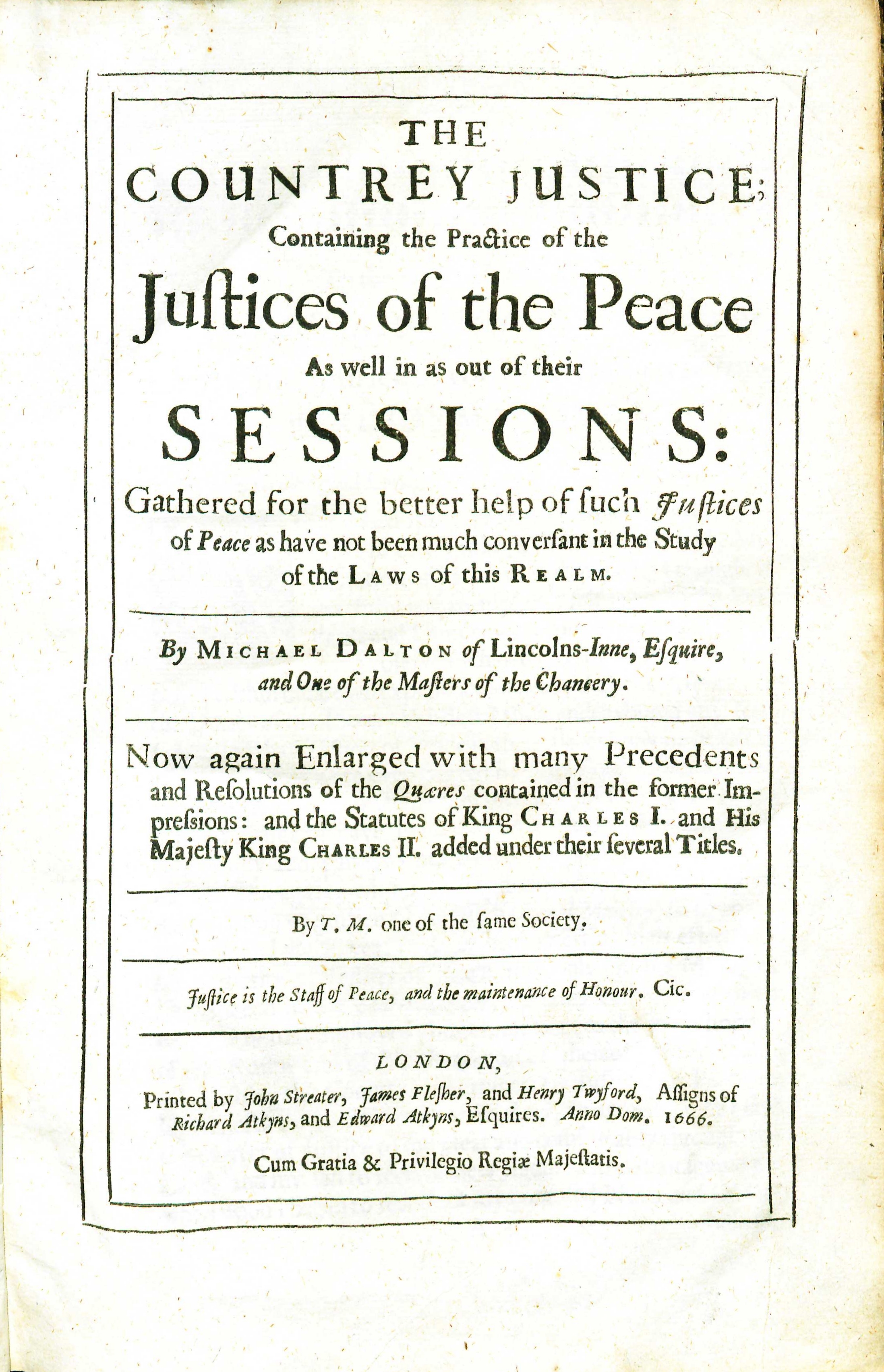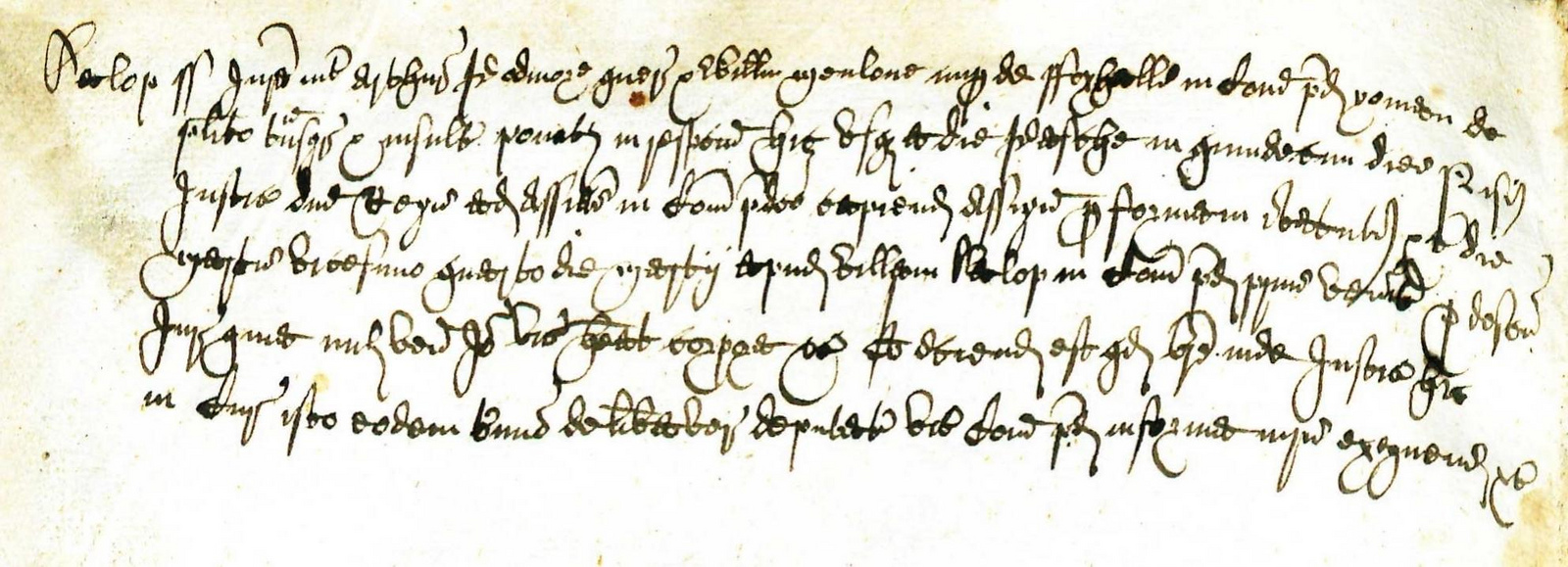Difference between revisions of "Countrey Justice"
Mvanwicklin (talk | contribs) m |
m |
||
| (One intermediate revision by one other user not shown) | |||
| Line 4: | Line 4: | ||
{{BookPageInfoBox | {{BookPageInfoBox | ||
|imagename=DaltonCountreyJustice1666 TitlePage.jpg | |imagename=DaltonCountreyJustice1666 TitlePage.jpg | ||
| − | |link= | + | |link=https://wm.primo.exlibrisgroup.com/permalink/01COWM_INST/g9pr7p/alma991002005469703196 |
|shorttitle=The Countrey Justice | |shorttitle=The Countrey Justice | ||
|author=[[:Category:Michael Dalton|Michael Dalton]] | |author=[[:Category:Michael Dalton|Michael Dalton]] | ||
| Line 15: | Line 15: | ||
|desc=[[:Category:Folios|Folio]] (28 cm.) | |desc=[[:Category:Folios|Folio]] (28 cm.) | ||
|shelf=L-5 | |shelf=L-5 | ||
| − | }}Michael Dalton (1564 – 1644) was a barrister and legal writer, a member of [[wikipedia:Lincoln's Inn|Lincoln's Inn]], and a justice of the peace in the counties of Essex and, later, Cambridgeshire.<ref>D.A. Orr, "[http://www.oxforddnb.com/view/article/7067 Dalton, Michael (1564-1644)]" in ''Oxford Dictionary of National Biography'', accessed May 21, 2015.</ref> ''The Countrey Justice'', a manual for justices of the peace and local magistrates, remains his best known work.<ref>Ibid.</ref> | + | }}[[Wikipedia: Michael Dalton (legal writer)| Michael Dalton]] (1564 – 1644) was a barrister and legal writer, a member of [[wikipedia:Lincoln's Inn|Lincoln's Inn]], and a justice of the peace in the counties of Essex and, later, Cambridgeshire.<ref>D.A. Orr, "[http://www.oxforddnb.com/view/article/7067 Dalton, Michael (1564-1644)]" in ''Oxford Dictionary of National Biography'', accessed May 21, 2015.</ref> ''The Countrey Justice'', a manual for justices of the peace and local magistrates, remains his best known work.<ref>Ibid.</ref> |
[[File:DaltonCountreyJustice1666InitialCapital.jpg|left|thumb|200px|<center>Initial capital.</center>]] | [[File:DaltonCountreyJustice1666InitialCapital.jpg|left|thumb|200px|<center>Initial capital.</center>]] | ||
| Line 30: | Line 30: | ||
Recent full blind calf, gold tooled edges; annotation [in Law French?] upside-down in brown/black ink on flyleaf. | Recent full blind calf, gold tooled edges; annotation [in Law French?] upside-down in brown/black ink on flyleaf. | ||
| − | Images of the library's copy of this book are [https://www.flickr.com/photos/wolflawlibrary/sets/72157659732745029 available on Flickr.] View the record for this book in [ | + | Images of the library's copy of this book are [https://www.flickr.com/photos/wolflawlibrary/sets/72157659732745029 available on Flickr.] View the record for this book in [https://wm.primo.exlibrisgroup.com/permalink/01COWM_INST/g9pr7p/alma991002005469703196 William & Mary's online catalog.] |
===Full text=== | ===Full text=== | ||
Latest revision as of 10:50, 27 October 2021
by Michael Dalton
| The Countrey Justice | |
|
Title page from The Countrey Justice, George Wythe Collection, Wolf Law Library, College of William & Mary. | |
| Author | Michael Dalton |
| Published | London: Printed by John Streater, James Flesher, and Henry Twyford, assigns of Richard Atkyns, and Edward Atkyns, esquires |
| Date | 1666 |
| Language | English |
| Pages | [14], 460 (i.e. 456), [10] |
| Desc. | Folio (28 cm.) |
| Location | Shelf L-5 |
Michael Dalton (1564 – 1644) was a barrister and legal writer, a member of Lincoln's Inn, and a justice of the peace in the counties of Essex and, later, Cambridgeshire.[1] The Countrey Justice, a manual for justices of the peace and local magistrates, remains his best known work.[2]
The office of justice of the peace originated during the Middle Ages, when their primary responsibility was to suppress riots and keep the peace.[3] By the sixteenth century, their power had increased and come to include various judicial and administrative tasks.[4] Most justices of the peace, however, had no legal training, and a number of justice of the peace manuals were published to provide guidance in the form of clear, comprehensive, and easy to understand instruction.[5]
The Countrey Justice was among the most popular manuals, and was published in at least twenty editions between 1618 and 1746.[6] It provided a summary of the current law on a diverse array of subjects, from robbery and murder, to cattle and sheep, and included a particularly detailed description of the proper procedure for prosecuting witches. One of the earliest manuals to be arranged in alphabetical order, Dalton’s book was popular both in England and New England, where it provided a ready and accessible summary of the English common law for the new colonies.[7]
Evidence for Inclusion in Wythe's Library
In her 1975 Colonial Williamsburg memo, Barbara Dean lists Dalton's Countrey Justice as a book Wythe could have had in his collection, citing "Virginia Lawyers, 1680-1776: The Birth of an American Profession" (1967), which lists it as a common title in Colonial lawyers' libraries.[8] Wythe definitely did own a copy of Dalton's Officium Vicecomitum, which appears in the inventory of books Wythe willed to Thomas Jefferson in 1806 as "Dalton's sheriff. fol." The Brown Bibliography[9] lists the 1666 edition of Countrey Justice and notes that "Virginia statutes required that each county justice have a copy ... as a primary reference work." Since Wythe was a justice of the peace in Elizabeth City County, he must have owned one. Brown selected the 1666 edition based on the copy Jefferson sold to the Library of Congress in 1815,[10] but notes that which copy Wythe owned is unknown. The Wolf Law Library moved an existing copy of the 1666 edition to the George Wythe Collection.
Description of the Wolf Law Library's copy
Recent full blind calf, gold tooled edges; annotation [in Law French?] upside-down in brown/black ink on flyleaf.
Images of the library's copy of this book are available on Flickr. View the record for this book in William & Mary's online catalog.
Full text
See also
References
- ↑ D.A. Orr, "Dalton, Michael (1564-1644)" in Oxford Dictionary of National Biography, accessed May 21, 2015.
- ↑ Ibid.
- ↑ Mike Widener, "The Taussig Collection: Justice of the peace manuals," Yale Law School: Lillian Goldman Law Library, April 21, 2014.
- ↑ Ibid.
- ↑ Ibid.
- ↑ Helen L. Hull, "'Lowe and lay ministers of the peace;' The Proliferation of Officeholding Manuals in Early Modern England," in Renaissance Papers 2009, ed. Christopher Cobb (Rochester, NY: Camden House, 2010), 47.
- ↑ Edgar J. McManus, "Laws for Living Saints," in Law and Liberty in Early New England: Criminal Justice and Due Process, 1620-1692 (Amherst, MA: University of Massachusetts Press, 1993), 12.
- ↑ Alan Smith, "Virginia Lawyers, 1680-1776: The Birth of an American Profession" (Ph.D. dissertation, John Hopkins University, 1967).
- ↑ Bennie Brown, "The Library of George Wythe of Williamsburg and Richmond," (unpublished manuscript, May, 2012) Microsoft Word file. Earlier edition available at: https://digitalarchive.wm.edu/handle/10288/13433.
- ↑ E. Millicent Sowerby, Catalogue of the Library of Thomas Jefferson (Washington, D.C.: The Library of Congress, 1952-1959), 2:303 [no.1966].


